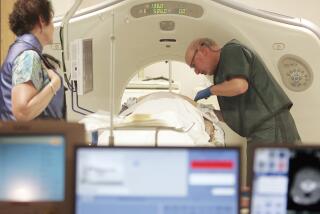Education should accompany prostate screening, new guidelines say
- Share via
New guidelines for prostate cancer screening issued Wednesday emphasize that physicians should better educate men about both the risks and benefits of using the PSA test for screening.
They also call for cutbacks in the use of digital rectal exams to find tumors and recommend the end of mass prostate-screening programs at health fairs and other sites.
The revised guidelines issued by the influential American Cancer Society come on the heels of several studies suggesting that large numbers of tumors identified by PSA screening are inconsequential and that biopsies and treatment produce more harm than those tumors would.
Because of such findings, the new guidelines emphasize the importance of physicians explaining both risks and benefits to the patients more fully so that each man can make an informed decision about whether to get tested.
Perhaps recognizing that physicians are unlikely to invest greater amounts of time in such educational efforts, however, the society also urged greater use of education specialists, pamphlets, videos and other materials to explain the risk-benefit trade-offs.
The panel that issued the guidelines called for cutbacks in community screening programs precisely because such educational efforts are rarely, if ever, incorporated.
And the group downplayed the importance of digital rectal examinations -- procedures that were once a mainstay of physical exams for men over 50 but which have become less common in recent years -- because of lack of evidence that they save lives.
Dr. Otis W. Brawley, chief medical officer of the American Cancer Society, said the new guidelines were not that different from those issued in 1997 and 2001.
Now, he added, “we have two clinical trials that very vividly illustrate the uncertainties associated with screening,” which makes it even more important for men contemplating the PSA tests to understand the risks. Those major trials showed that PSA screening does not lower the risk of death from prostate cancer and might actually increase it slightly, perhaps from unnecessary treatments.
Dr. S. Adam Ramin, a urological oncology specialist at St. John’s Health Center in Santa Monica, said that the cancer society guidelines placed too much emphasis on whether the tests saved lives and not enough on whether they prevented complications from tumors, such as leaking of urine, incontinence, bone pain, anemia and weight loss.
“Although it is true that treatment will not necessarily save a lot of lives, it does prevent complications,” he said.
But other experts noted that treatment itself can produce complications such as urinary incontinence and impotence.
Skip Lockwood, president of Zero -- The Project to End Prostate Cancer, said that calls to end the digital rectal exam were “kind of nuts. . . . The whole concept that you would do anything to reduce the amount of information you have does not make sense to me.”
He said his organization would continue its mass screening programs with PSA tests, which have tested more than 100,000 men.
Several medical groups, including the American Urological Assn. and the National Comprehensive Cancer Network, now offer guidelines on screening with the PSA test, which measures levels of a tumor-associated protein in blood.
Prostate cancer is the most common cancer in men after skin cancer, affecting 192,000 men each year and killing 27,000. And though all the parties may not concur on how and how often PSA screening should be used, they are in unanimous agreement on one point. As Lockwood said, “We need a better test.”
thomas.maugh@
latimes.com






